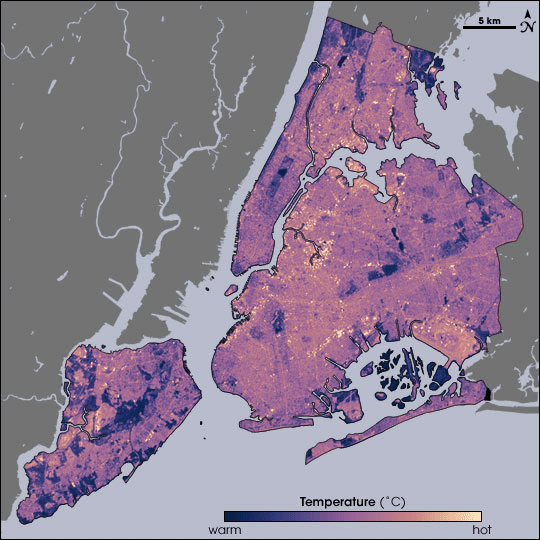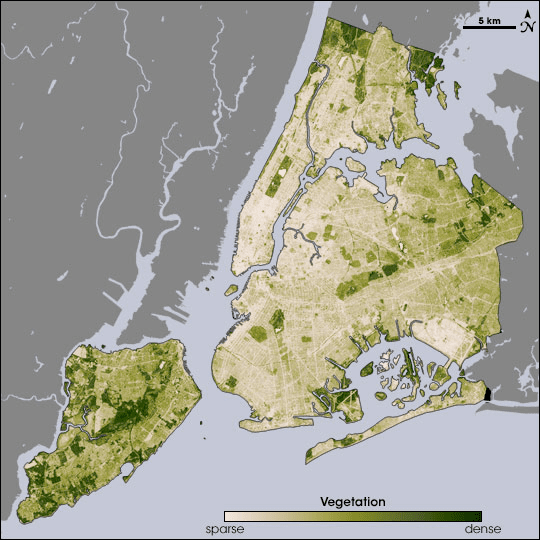“The geometry, spacing and orientation of buildings and outdoor spaces” [Kleerekoper 2012: 30], as well as the prevalence of hard surfaces and reduced amount of vegetation, strongly modify the micro-climate of urban areas compared to rural surroundings. Characterized by an increase in temperature, a phenomenon referred to as urban heat island [UHI] effect has multiple causes. This includes, for example:
- Absorption of short-wave radiation from the sun in low albedo (low-reflection/high-absorption) materials
- Absorption and re-emission of longwave radiation by pollution
- Heat released through combustion from traffic, heating and industries
- Reduction of wind speed and obstruction of sky view by buildings, resulting in lowered heat loss from street “canyons”
- Decreased evaporation due to a surfeit of impermeable surfaces
An increase in global temperature combined with UHI may have serious health implications including death. The heatwave of 2006 resulted in about a thousand heat-related deaths in the Netherlands and was rated fifth-worst natural disaster of that year. Cities can reduce the UHI effect with adaptive measures that combine vegetation, water, built form and material.
“Vegetation cools the environment actively by evapotranspiration and passively by shading surrounding surfaces that otherwise would have absorbed short-wave radiation” [Kleerekoper 2102: ]. Such methods include expanding urban forests/parks, street trees, private gardens, and green walls or roofs. “Vegetation has an average cooling effect of 1 – 4.7C that spreads 100 – 1,000m into an urban area, but is highly dependent on the amount of water the plant or tree has available” [Kleerekoper 2012: ]
Water cools by evaporation, or by transporting heat out of the city as does a river or stream. The cooling effect of water ranges from 1 – 30C to a distance of 30 – 35m, with stagnant water cooling the least and flowing and dispersed water (like a fountain) cooling the most. Water also cools through permeable pavement and water storage infrastructure that makes it available to trees for transpiration.
The built form of cities increases the UHI effect by reducing heat loss when tall buildings block the release of long-wave radiation back up toward the sky, while also blocking wind ventilation. While city form is hard to change, any new development can opt to reduce the height to width ratio of streets to allow better ventilation and heat loss. Slanted roofs also increase ventilation.
Lastly, the choice of building materials affects the UHI effect. Permeable materials facilitate evaporation and light/white (high albedo) materials reflect short-wave solar radiation, thus cooling the city. By contrast, “waterproof” and dark materials reduce evaporation and absorb short-wave radiation, thus contributing to the UHI effect. A simulation model for Sacramento, CA, showed a 1 – 4C drop in temperature from a city-wide increase in albedo (such as through white rooftops) from 25 to 40%.
Despite the existence of a substantial body of knowledge on the causes of and solutions to the UHI effect, the transfer of this knowledge to city planners is often lacking. Due to differences in aim, focus, and expression among the various actors in the city planning process, as well as the theoretical (rather than practical) nature of scientific studies discussing the UHI effect, communication about UHI-reduction design solutions can be a challenge. Furthermore, quantification is often lacking in terms of heat accumulation for a given area, maximum acceptable levels of heat, and the quantity of needed measures to reduce UHI (number of trees or square meters of green space, for example) .
However, certain cities like Stuttgart have developed spatial parameters in urban planning guidelines with respect to climate change. In California a cool-roof material with low thermal admittance has been introduced in the Building Energy Efficiency Standard regulation of the state. The city of Portland is creating a reference guide of pavement options for low-use traffic zones. The greening policy in Chicago and Edinburgh involves increasing the number of street trees, as well as species heterogeneity to ensure resistance to vegetal disease (given that species diversity limits pest infestation).


Photo description: vegetated areas are cooler
Kleerekoper, Laura, Marjolein van Esch & Tadeo Baldiri Salcedo, 2012, How to make a city climate-proof, addressing the urban heat island effect, Resources, Conservation and Recycling 64, https://www.sciencedirect.com/science/article/pii/S0921344911001303.
